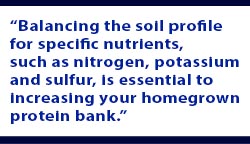
Doubling down on homegrown proteins
 By Steve Murty
By Steve Murty
Feed prices have increased substantially in recent months. Further complicating the cost situation, the winter storm that blew through Texas froze water pipes and natural gas lines, which created a short-term deficiency of feed-grade urea. These two unpredictable incidents emphasize how important it is to double down on forage management practices to preserve homegrown protein yields and save out-of-pocket expenses.
Soil nutrition
Doubling down to maximize homegrown forage protein sources begins with proper soil nutrition. Balancing the soil profile for specific nutrients – such as nitrogen, potassium and sulfur – is essential to increasing your homegrown protein bank.
- On average, 1 ton of grass hay containing 12.5% crude protein will remove 40 pounds of nitrogen per acre. All cool-season and warm-season grasses need adequate nitrogen to grow, but it needs to be in the proper form. Plants absorb nitrogen in the form of nitrate, ammonium ions and urea. Plants that are nitrogen-deficient will start to show signs on older leaves because nitrogen is mobile and will move up the plant to the newest leaves. The yellowing will become visible on the leaf margins.
- Sulfur and potassium work with nitrogen to improve protein in forages. Sulfur-deficient plants are often stunted, thin-stemmed, spindly plants, and they are commonly confused with nitrogen-deficient plants because they appear weak and pale in color. In contrast to nitrogen deficiency, sulfur deficiency shows up on newer leaves first because sulfur is an immobile nutrient in the plant.
- Potassium influences enzyme activity, water and energy relations, transpiration and translocation, nitrogen uptake, and protein synthesis. Potassium is a mobile nutrient like nitrogen. Deficiencies will appear on older leaves first, starting at the tip and moving down the midrib and center portion of the leaf.
Diversity
Adding diversity within the grasses you plant is another way to increase your protein bank. The addition of peas to a winter or spring cereal can improve protein content by 3% to 5%, but it may not substantially increase yield. If you choose to add peas to your grasses, use a drill to achieve better seed-to-soil contact and plant in early spring to allow 50 to 60 days of growth.
Harvest timing
Proper harvest timing is essential to maximize protein yields. Harvesting cereal grains at the flag leaf or boot stage is necessary to increase (or optimize) protein content. If harvest is delayed, advanced maturity can reduce protein content by 6% to 8%.
First-cutting alfalfa is also more susceptible to potential protein loss through dropped leaves. Prior to first cutting, alfalfa leaf retention can be improved with fungicide applications. If spring is unusually early and wet, you can expect a higher incidence of leaf diseases, which will cause the leaves to weaken and detach during harvest.
With volatile feed and protein prices, it is never too late to put together a plan to maximize as much homegrown protein as possible. Talk with your Vita Plus consultant to learn more about these forage management strategies to preserve your feed investment and profitability.
About the author: Steve Murty joined the Vita Plus team in 2018 as a forage product specialist. He attended Iowa State University to earn a degree in animal science with a minor in agricultural systems technology. He previously managed the grain, agronomy, seed and retail departments at a local cooperative before transitioning to a sales role with a seed dealer. Murty is also a certified crop advisor (CCA) with a passion to work with farmers and help them meet their forage production goals. Living in Iowa, Murty is a local 4-H club leader, a member of the Tama County Cattlemen, and an active member of his local church
| Category: |
Dairy Performance Drought Feed quality and nutrition Forage harvesting Forage inoculants Forage storage and management |

